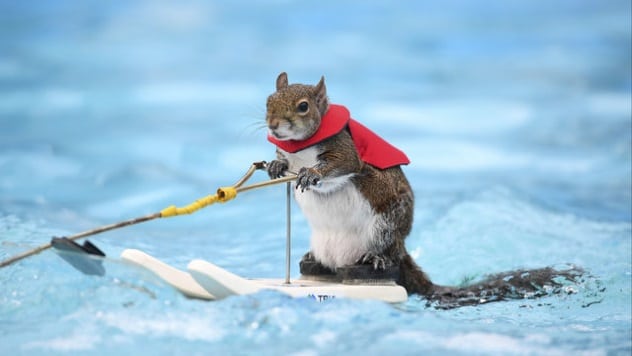 Weird Stuff
Weird Stuff  Weird Stuff
Weird Stuff  Animals
Animals 10 Inspiring Tales of Horses Being Human
 Mysteries
Mysteries Top 10 Haunting Facts About the Ghost Ship MV Alta
 History
History 10 Surprising Stories About the Texas Rangers
 Humans
Humans 10 Philosophers Who Were Driven Mad by Their Own Theories
 Miscellaneous
Miscellaneous 10 Video-Game-Worthy Weapons and Armors from History
 Weird Stuff
Weird Stuff 10 Psychics Who Accurately Predicted Wartime Events
 The Arts
The Arts 10 Pieces of Art Inspired by a Broken Heart
 Health
Health 10 Science Fiction-Sounding New Medical Treatments
 History
History 10 Surprising Facts About the Father of Submarine Warfare
 Weird Stuff
Weird Stuff 10 Times Real Laws Were Based on Bizarre Hypotheticals
 Animals
Animals 10 Inspiring Tales of Horses Being Human
 Mysteries
Mysteries Top 10 Haunting Facts About the Ghost Ship MV Alta
Who's Behind Listverse?

Jamie Frater
Head Editor
Jamie founded Listverse due to an insatiable desire to share fascinating, obscure, and bizarre facts. He has been a guest speaker on numerous national radio and television stations and is a five time published author.
More About Us History
History 10 Surprising Stories About the Texas Rangers
 Humans
Humans 10 Philosophers Who Were Driven Mad by Their Own Theories
 Miscellaneous
Miscellaneous 10 Video-Game-Worthy Weapons and Armors from History
 Weird Stuff
Weird Stuff 10 Psychics Who Accurately Predicted Wartime Events
 The Arts
The Arts 10 Pieces of Art Inspired by a Broken Heart
 Health
Health 10 Science Fiction-Sounding New Medical Treatments
 History
History 10 Surprising Facts About the Father of Submarine Warfare
10 Offbeat Stories You Might Have Missed This Week (7/28/18)
With another week gone, let’s wind down and check out some of the stories that made the headlines. Click here to read about all the important goings-on of the world, but otherwise, press on for a dose of the unusual and offbeat.
There were a lot of space-related stories over the last few days. Mars, in particular, had a busy week with news of an underground lake, a dust storm for the ages (more on that below), and efforts to name a new Martian rover. (Yes, they thought of “Rover McRoverface.”) We also check out some bizarre animal behavior, Olympic Games for robots, and footage of the world’s loneliest man.
10 DARPA Plans Olympics For Tiny Robots

The Defense Advanced Research Projects Agency (DARPA) announced a new initiative to develop tiny robots that would work in tough environments where large-scale robots are not effective. The new program, dubbed SHort-Range Independent Microrobotic Platforms (SHRIMP), will seek proposals from third parties, and the best bots will compete against each other in a series of “Olympic-themed competitions.”
Founded 60 years ago, DARPA is an agency of the United States Department of Defense. It has staged these kinds of grand challenges before in efforts to advance revolutionary research with military potential. According to SHRIMP program manager Dr. Ronald Polcawich, this time, the goal is to develop tools which could prove useful in disaster relief, emergency search and rescue, prosthetics, and steerable optics.[1] DARPA is planning to invest $32 million across the projects accepted into the SHRIMP program.
The first step is to receive and review proposals for suitable robots. They need to be smaller than a cubic centimeter and weigh less than a gram to qualify. Eventually, the best designs will be built and will compete head-to-head in a series of challenges, including steeplechase, vertical ascent, shot put, weightlifting, and rock piling. The SHRIMP Olympics is currently slated for 2021.
9 Andromeda Cannibalized Our Sibling Galaxy

According to a new study published in Nature Astronomy, scientists believe that there once was another galaxy similar to our Milky Way which was “devoured” by Andromeda two billion years ago.
Both Milky Way and Andromeda are part of an aggregation of galaxies simply called the Local Group. It contains over 50 galaxies, although the aforementioned two are, by far, the largest ones. Research conducted at the University of Michigan (UM) indicates that there once existed a third galaxy of similar dimensions which was cannibalized when it merged with Andromeda.
The fact that Andromeda, also known as Messier 31 or M31, likes to gobble up its galactic neighbors isn’t news. In fact, this is exactly what UM researchers Richard D’Souza and Eric Bell were studying when they made the discovery. They were running computer simulations to try to piece together the mergers that occurred over the eons. In a self-described “eureka” moment, the duo realized that most of the stars found in the faint outer reaches of Andromeda’s “halo” came from a single merger.[2]
Further simulations revealed a few details about the Milky Way’s departed sibling, dubbed M32p. It was at least 20 times bigger than anything our galaxy ever collided with, and it merged with Messier 31 around two billion years ago. Most interestingly, researchers believe that M32, a satellite galaxy currently orbiting Andromeda, is the remnant of the long-lost galaxy, left over after the galactic giant was finished feasting.
8 Amazon Footage Shows Last Surviving Tribesman
Brazilian officials have recently released rare video of an indigenous man living in the Amazon who is believed to be the last surviving member of an uncontacted tribe.
The footage belongs to the country’s National Indian Foundation (Funai) and was actually shot in 2011. The organization hesitated to release it due to not being able to obtain the man’s consent. However, it eventually relented in the hopes that the video will draw attention to the plight of over 100 isolated tribes living in the Amazon whose territory is under threat by loggers, miners, and farmers.
It is believed that the last of the man’s fellow tribesmen were killed in 1995 or 1996, following a run-in with ranchers. Funai has monitored him ever since. They usually keep a safe distance, although they did attempt to make contact in 2005 and were met by a volley of arrows.
Barring that one interaction, the tribesman has been living alone in the jungle for over two decades. The only other image of him is a still from an early-1990s documentary that showed his face partially obscured by foliage. His tracking team refers to him as “the Indian in the hole” due to an unusual pit he dug.[3] Their last sighting was in 2016, but they can tell he is still alive from traces left behind such as footprints, planted fruit, or cut trees.
7 Why Do Crows Have Sex With The Dead?
Considered some of the most intelligent animals on the planet, crows have complex reactions when it comes to their own dead. They will alert other crows to the presence of a body. They will remember and avoid people or places connected to the demise of their brethren. Sometimes, they will even gather around a dead crow and hold a “funeral.” And, on rare occasions, they will have sex with the corpse.
Necrophilia in the animal kingdom is a poorly understood subject, but we have a few tidbits of information regarding the practice by crows, thanks to a new paper published by University of Washington student Kaeli Swift.
Back in 2015, Swift was trying to get footage of a crow “funeral” and was filming a taxidermied bird. To her amazement, another crow arrived, but it began flaring its wings and bobbing its tail up and down, displaying behavior anticipatory of sex. Since then, Swift expanded her study and used an array of taxidermy animals to observe the behavior of hundreds of crows.
Her research presented the cases of 309 breeding pairs of corvids. Twenty-four percent of the birds had some kind of physical interaction with the corpses, while four percent tried to have sex with them.[4] Most attempts at necrophilia were also paired with other aggressive behaviors such as mutilation and dismemberment.
As far as a possible motive goes, Swift believes it has to do with a hormonal frenzy. Her study took place between April and August, bookending the breeding season. Most cases of necrophilia happened in late spring, when crow testosterone is at a high. Other crow researchers think this could be the case but believe another study during winter could prove more conclusive.
6 Martian Dust Storm Might Destroy The Opportunity Rover
While Earth is experiencing a searing heat wave, Mars has its own weather problem—a series of storms created a dust cloud so great that it has almost engulfed the entire planet.
This kind of phenomenon occurs once every six to eight years. It started off as a small-scale storm on May 30, and less than a month later, it had gone global. By now, it has become the strongest dust storm we have ever observed on Mars, and it will last, at least, a couple of months more.
Scientists still don’t know how the storm forms or evolves, so they have every available instrument studying the tempest for clues. The Mars Reconnaissance Orbiter, MAVEN, Curiosity, and the Mars Odyssey are all on the job.
Notable by its absence is the Opportunity rover, which is currently on the surface of the red planet yet has sent no response as of July 18.[5] Because it runs on solar energy, NASA scientists have chosen to suspend scientific activities to preserve the rover’s batteries. They believe the dust layer will act as an insulator which will protect Opportunity from nighttime temperatures it can’t handle but also fear that it will take weeks or even months before such a layer settles. Currently, they estimate it won’t be until September that the dust will clear out enough to enable communication with Opportunity again. Until then, we won’t know if the rover survived the Martian storm.
5 We Opened Another Untouched Tomb

A tomb found in Alexandria garnered a lot of media attention over the past few weeks. It had been untouched for 2,000 years and contained a mysterious black sarcophagus. People let their imaginations run wild, even speculating that it could be the long-lost grave of Alexander the Great. Then we opened it, and the results were underwhelming. A similar discovery went under the radar this week. Archaeologists found an intact grave on the Greek island of Sikinos.
This time, however, opening the tomb didn’t disappoint. The skeleton was intact, her jewelry was still there, and we even know her name thanks to an inscription—Neko.[6] She was a noblewoman buried around 1,800 years ago during the Roman era in the vault of the Episkopi Monument. The structure was later turned into a Byzantine church, but Greek archaeologists now believe that the whole thing was a mausoleum originally built for Neko.
Alongside the skeleton, there were golden rings, wristbands, a necklace, a buckle, vases, and fragments of clothing. Dimitris Athanassoulis, director of the Ephorate of Antiquities of Cyclades, believes the grave managed to elude robbers due to its hidden placement in a blind spot between two walls. Scholars are eager to learn more about Neko and her possible connections to the island of Sikinos.
4 Twiggy Water-Skis Into The Sunset

After almost 40 years in show business, Twiggy the water-skiing squirrel is retiring. The 39-year-old novelty act had its final performance on Sunday during the X Games in Minneapolis.[7]
Some of you might be aware that squirrels don’t live that long. In fact, this is the seventh Twiggy to don a pair of Styrofoam skis and race around a pool at the back of a remote-controlled boat. Her “mom,” Lou Ann Best, raised and trained all of the squirrels. The first one she found as an orphan after Hurricane David in 1979, and she noticed that it liked to ride on people’s shoulders as they swam in the pool.
Twiggy’s popularity led to several appearances in movies and TV shows, including a cameo as Nutty the water-skiing squirrel in Anchorman: The Legend of Ron Burgundy.
Lou Ann has been using the show to teach kids about water safety ever since her husband drowned over two decades ago. But now she plans to retire to a senior community, and Twiggy is coming with her. She is open to selling the business and letting someone else carry the tradition as long as they will continue promoting water safety.
3 A New Scale To Measure Alien Interactions

A team of scientists from the University of St. Andrews and the SETI Institute published a redefined version of the Rio Scale intended to quantify the significance of alien reports.[8]
First devised in 2001, the Rio Scale was mostly used by astronomers to communicate to the public how “excited” they should be following a story potentially involving extraterrestrial phenomenon. The updated version seeks to become more compatible with the world of social media and 24-hour news coverage. Researchers involved are hoping that Rio Scale 2.0 will become somewhat similar to the Richter Scale for earthquakes and will be used automatically whenever there is a story involving possible alien interaction.
The ranking system comes with a Rio Scale Calculator available online, which anyone can use to determine the value of an event. The scale takes into account the likelihood of the event and the reliability of the source but also considers how such an event, even if real, would impact humanity. The final value is a number between 0 (None) and 10 (Extraordinary). Rio Scale 2.0 is awaiting official ratification by the International Academy of Astronautics Permanent Committee.
2 Naturists Versus Crested Larks

An attempt by Belgian naturists to open the country’s second nudist beach was met with opposition by wildlife officials, who complained that their presence and “subsidiary activities” would pose a threat to the crested lark.
At the moment, there is only one nudist beach in Belgium, in Bredene. However, Koen Meulemans, chair of the Belgian Naturism Federation, says that is no longer enough. More and more people in the country are looking for holidays where they can cast off their clothes and go back to nature. The federation has 17 clubs and 8,200 paying members, an increase of 600 from two years ago. A quiet spot near Westende would have made a perfect location for a second nudist beach, as there are no buildings or dykes that look out onto it.
However, officials from the Flemish Agency for Nature and Woodland objected to the proposition due to the effect this would have on the crested lark.[9] Specifically, they worry that sex in the dunes will scare off the locally treasured birds. Meulemans criticized the practice, saying such behavior is not indicative of true naturists, but it does happen.
The initial solution involved the building of a barbed wire fence surrounding the dunes where the larks breed. However, this was shut down by Bredene mayor Steve Vandenberghe, who said that barbed wire would not be a strong deterrent against a man without clothes.
1 Star Proves Einstein Right

One of the processes predicted by Einstein’s theory of general relativity is called gravitational redshift. When an object approaches something with an incredibly powerful gravitational pull, the light it emits is stretched to longer wavelengths, becoming redder. We have proven the concept with lab experiments but have never actually seen it “in the wild,” until now. Scientists finally made the observation after decades of waiting when a star experienced gravitational redshift as it passed near the black hole at the center of our galaxy.
Astronomers first started tracking the star, dubbed S2, in the early 1990s. Since then, they’ve been patiently waiting for it to complete its elliptical orbit around the black hole, located roughly 26,000 light-years from us.
S2 got as close as it’s ever going to get on May 18 this year. Instruments from all over the world were pointing at it. When it reached its periapsis, the star accelerated to 7,600 kilometers per second (4,700 mi/s), or three percent the speed of light.[10] The results, published in Astronomy & Astrophysics by an international team of scientists, confirmed that light from the star was affected by the gravitational pull of the black hole and experienced a redshift.
Read more offbeat stories you might have missed from July 21, 2018 and July 14, 2018.








